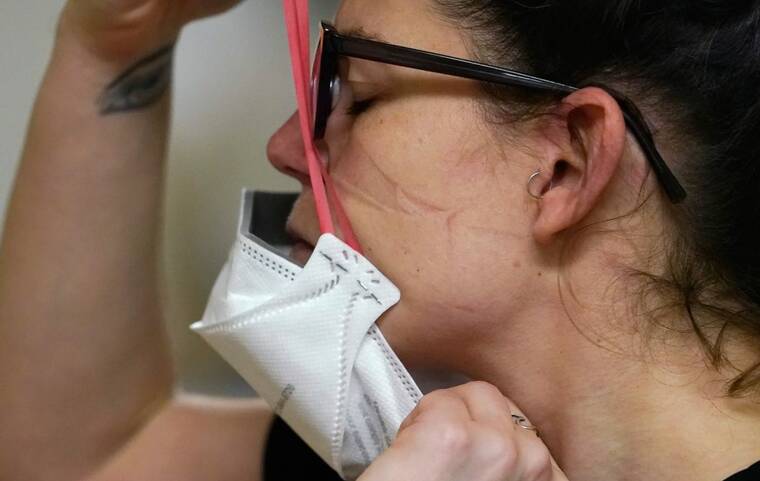Is it time to wear a mask again?

ASSOCIATED PRESS
Registered nurse Jessalynn Dest pulls on a new N95 mask as indentations remain from another she had just removed after leaving a COVID-19 patient room in the acute care unit of Harborview Medical Center, in January 2022, in Seattle. Experts say it makes sense to increase precautions, including turning back to masks.
EXPERTS RECOMMEND WHEN AND HOW TO USE THEM, AS COVID CONTINUES TO CIRCULATE.
As new COVID variants gain traction, reinfections become more common and cases climb in certain areas, a few schools and businesses are reinstating mask requirements. Experts say it makes sense to increase precautions, including turning back to masks.
“I tend to say, if you’re going to go out, make sure you have a mask in your car, a couple masks at home or at work, so you always have something available to put on,” said Andrew Pekosz, a professor of molecular microbiology and immunology at the Johns Hopkins University Bloomberg School of Public Health.
Here’s a refresher on where, when and how to mask.
WHEN SHOULD YOU WEAR A MASK INSIDE?
Everyone’s risk tolerance varies, Dr. William Schaffner, an infectious disease specialist at the Vanderbilt University School of Medicine, said. But particularly if you are 65 or older, have an underlying condition that makes you more vulnerable to severe disease or are pregnant, he recommends wearing a mask whenever you are in a relatively confined, crowded indoor space. That can include stores, offices and public transportation.
Don't miss out on what's happening!
Stay in touch with breaking news, as it happens, conveniently in your email inbox. It's FREE!
“Certainly every time you add another person to the room, particularly people who are within three to five feet of you, that increases your chance of getting infected, exponentially,” Dr. Pekosz added.
Time matters, too: Darting in and out of a packed grocery store is less risky than working all day in a busy office, for example. Ten minutes is a good marker to keep in mind, Dr. Pekosz said. If you’re headed somewhere indoors for longer than that, you may want to consider putting on a mask beforehand.
WHEN SHOULD YOU WEAR A MASK OUTSIDE?
Outdoor transmission is generally rare, but if you’re in a scenario where people are “jammed together and yelling,” Dr. Schaffner said, like at a sporting event or a concert, you might want to wear a mask.
Linsey Marr, an expert in the airborne transmission of viruses at Virginia Tech, said a good rule of thumb if you’re trying to avoid getting COVID is to opt for a mask if you’re elbow-to-elbow with other people: “When you’re in environments where you can reach out and touch someone.”
WHICH TYPE OF MASK SHOULD YOU WEAR?
Dr. Marr recommends N95, KN95 or KF94 masks, all of which filter out over 90 percent of virus particles, she said, making them far more effective than surgical or cloth masks at reducing your chance of getting infected with COVID. The Centers for Disease Control and Prevention has a list of resources for where to find free N95s.
The experts said that a mask should fit snugly across your face and cover both your nose and mouth; wearing a mask below your nose will do very little to shield you from the virus.
A high-quality mask “does wonders in terms of protecting you from getting infected, but you have to wear it the right way,” Dr. Pekosz said. “If you don’t crimp the metal thing around your nose, if it’s loose around you, then you’re probably breathing around the mask, not through the mask. And that is not going to protect you.”
Some experts estimate that you can use a mask for a total of about 40 hours before it’s time to replace it. If you notice fraying, creases, new holes or dirt on your mask, you should replace it before then, Dr. Marr said. If your mask is uncomfortable, or if you feel like it’s moving too much across your face, Dr. Marr recommends trying different brands to find the best fit.
DO YOU NEED TO MASK AFTER BEING EXPOSED?
If you get the dreaded text that someone you recently spent time with has tested positive for COVID, the C.D.C. recommends putting on a high-quality mask as soon as possible, and keeping it on for 10 full days when you’re around other people. Even if you test negative, the agency says you should still wear a mask in public indoor settings. It can take several days for people to develop symptoms, Dr. Pekosz said, and testing too early can lead to false negatives.
IS ONE-WAY MASKING EFFECTIVE?
Even if you’re the only person wearing one on the subway or in your office, a high-quality mask can still meaningfully reduce your risk of getting infected. “You’re going to be pretty well protected,” said Dr. Yvonne Maldonado, a professor of global health and infectious diseases at Stanford Medicine, because you’re guarding your face from the particles around you.
There are additional ways to build up your defenses against the virus: sanitizing your hands before touching your face, social distancing from others and getting an updated booster shot when the new vaccines are available.
While many people are exhausted by this long pandemic, Dr. Maldonado stressed it’s important to remember that we have tools to reduce our risk. “Masks work, period,” she said. “Whether you choose to use them or not is a different matter. But they definitely work.”
© 2023 The New York Times Company



